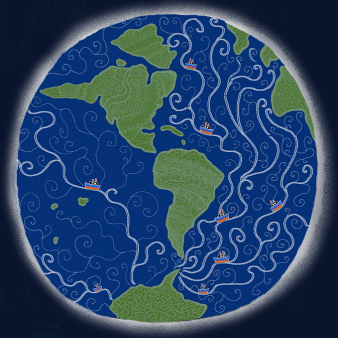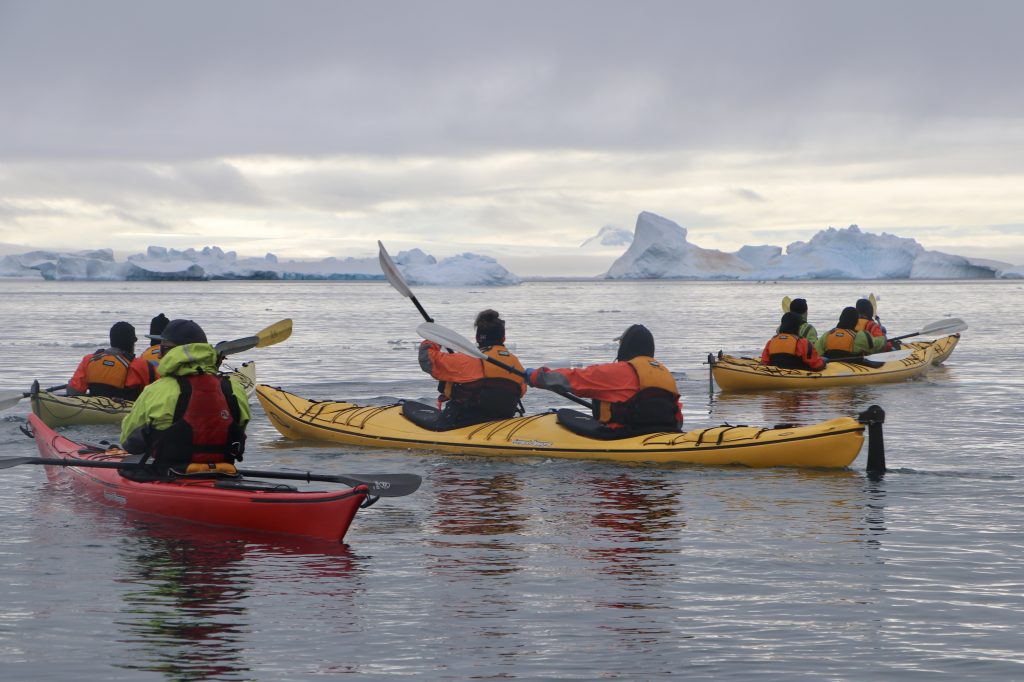Aliens and spaceships spotted in the Arctic!
15 June 2021
By the Polar Alien Hunters
An arresting tabloidesque headline perhaps, but one that is rooted in fact. The aliens are non-native species and the spaceships they travel on are the ships and airplanes that traverse the world, bringing scientists, tourists and trade to the Arctic ocean. These aliens can gain passage in many ways; often by hitching a ride on the ships’ hulls (biofouling), hiding in the cargo, or on the boots and clothing of unwary human hosts.
When they arrive, the alien species may find the Arctic inhospitable, with the year-round low temperatures and strong seasonality enough to prevent many of them surviving long in this harsh ecosystem. But some will. Ships that visit the Arctic travel the whole world, with some regularly visiting both polar regions each year (typically via the Atlantic Ocean). Their hulls are generally only cleaned every 1-3 years and transport diverse biological communities wherever they go, even though measures to reduce biofouling are frequently used. Thus cold weather specialists may be found amongst the visiting aliens.
Whether or not these species can establish populations in the Arctic or, indeed, if they will have negative effects on the native life is currently unknown. What we do know is that marine biosecurity measures, though logistically complex, are being adopted around the world and may provide some hope for reducing the introduction of alien species to the Arctic via ships.
Whether or not these species can establish populations in the Arctic or, indeed, if they will have negative effects on the native life is currently unknown. What we do know is that marine biosecurity measures, though logistically complex, are being adopted around the world and may provide some hope for reducing the introduction of alien species to the Arctic via ships.
Terrestrial aliens, like plants and insects, still often travel by ship. Biosecurity measures to prevent the spread of terrestrial species include careful inspections of cargo in ships’ holds and thoroughly washing and vacuuming all clothing and equipment that visitors bring (including vacuuming inside pockets!). However, some of these measures have only been implemented relatively recently.
Polar Alien Hunters
A small group of Polar Alien Hunters have combined forces to mobilise a defence against this threat. Arlie McCarthy (a marine ecologist at the University of Cambridge), Dr Jesamine Bartlett (a polar biologist at the Norwegian Institute for Nature) and Christy Hehir (a researcher in tourism and conservation at the University of Surrey) have teamed up to spread the word about the potential risks of alien species to the polar regions (with an initial focus on Antarctica), forming a public engagement and biosecurity campaign using comics.
Our vision for Polar Alien Hunters is to ensure that all visitors to the polar regions engage with and use the latest, best-practice biosecurity measures and, most importantly, understand why we need to keep Antarctica free of alien species. We share the stories of those alien species who have reached the polar regions and detect the few simple steps each visitor can take at home before leaving to slow down alien invasions.

Each of the alien hunters has their specialist role to play.
- Arlie hunts for alien species that live on the hulls of ships that visit Antarctica and the Arctic. She has scraped hulls and pipes, freeing ships of their barnacles and sludge to find out what species are already being transported to the polar regions and where in the world they come from.
- Jes is a terrestrial hunter, and looks for aliens at both ends of the earth, on the islands of the Antarctic, and Svalbard in the Arctic. Her organisation NINA (Norwegian Institute for Nature Research) also leads the ‘Stop Arctic Aliens’ programme, which educates visitors to the Arctic on the risk of “sneaky beasties”!
- Christy is a different breed of Polar Alien Hunter from Arlie and Jes. Christy is a social scientist, an environmental psychology expert whose research examines the role tourism plays in (re)connecting people to nature and investigates why some travel experiences are more likely than others to trigger new and lasting pro-environmental behaviours (like donating) once people return home.
Whilst the fear of irreversible impacts may be a trigger for people to visit the Arctic in the first place, fear and guilt tend not to prompt pro-environmental behaviours (like carbon off-setting). So what benefit, if any, does increasingly popular polar travel have for polar conservation? Christy’s research suggests that engaging tourists in citizen science, self-discovery (walking safaris) or the chance to absorb nature through existing past times (photography, music or art) helps people develop a deeper connection to and love of the Arctic environment. This emotional connection may transpire into actions to help protect it, including hunting for those sneaky beasties that find their way into our luggage as stowaways. In other words, visitors become “more than just tourists”, they become polar ambassadors.

The good news is that we can all do our bit to help protect the fragile Arctic environment. Anyone can become a Polar Alien Hunter; whether you are a tourist, scientist, logistician, crew or support staff visiting the Arctic. So next time you find yourself in a spaceship heading North, follow the biosecurity protocols and keep an eye out for any unusual sightings; you too will become a Polar Alien Hunter.
If you are interested in finding out more about Polar Alien Hunters, please visit the website www.polaralienhunters.com where you can find out about the project and get in contact with us. You can also follow us on Twitter @Polar_Aliens
Christy Hehir (@christyhehir) is a researcher in tourism and conservation at the University of Surrey.
Dr. Jesamine Bartlett (@JesamineCB) is a polar biologist at the Norwegian Institute for Nature.
Arlie McCarthy (@ArlieMcCarthy) is a marine ecologist at the University of Cambridge and the British Antarctic Survey.
- From the Floe Edge: Visualising Sea Ice in Kinngait, Nunavut
- Bridging Knowledge and Action: A Polish-Norwegian Perspective on Arctic Science-Policy Collaboration
- Unpacking the Motivation Behind Wintering at Polar Stations
- Working the Ocean’s White Gold: A Nutshell History of a Living Bering Strait Tradition
- Political Participation in the Arctic: Who is heard, when, and how?